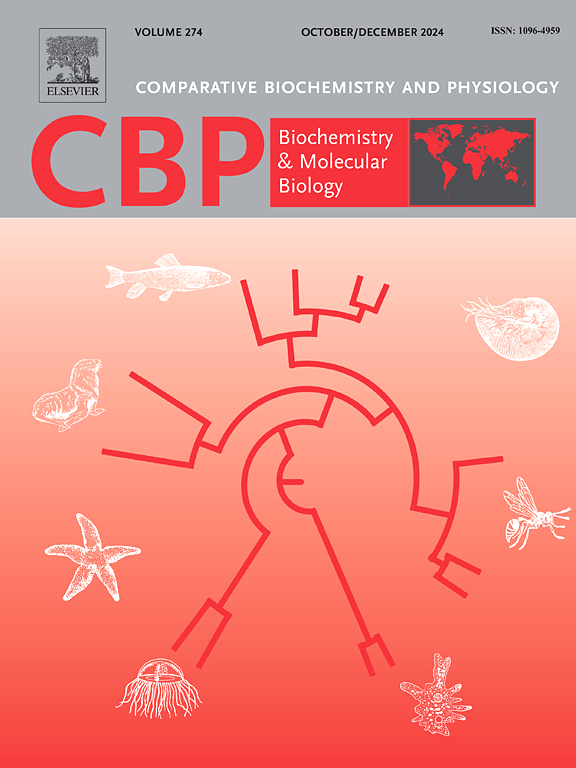Microplastic and Vibrio harveyi co-exposure induces oxidative stress in big-belly seahorse Hippocampus abdominalis
IF 1.8
3区 生物学
Q4 BIOCHEMISTRY & MOLECULAR BIOLOGY
Comparative Biochemistry and Physiology B-Biochemistry & Molecular Biology
Pub Date : 2025-07-05
DOI:10.1016/j.cbpb.2025.111124
引用次数: 0
Abstract
Microplastics in marine environments can act as vectors for pathogenic bacteria, increasing the risk of infection and physiological stress in marine organisms. Seahorses, which inhabit coastal ecosystems, may be vulnerable to the combined effects of microplastics and bacterial pathogens such as Vibrio harveyi. Therefore, the aim of this study was to investigate the effect of microplastic and bacteria co-exposure on big-belly seahorse (Hippocampus abdominalis). Microbeads (MBs) were introduced via water exposure, while V. harveyi was administered by injection. Seahorses were exposed to microbeads (MBs; concentration; 50 beads/L; size, 0.2 and 1.0 μm), V. harveyi (1 × 103 CFU/mL), and a combination of both for 4 days to evaluate oxidative stress responses. Tissue sampling was performed at 0, 1, 2, and 4 days. Notably, MB accumulation in the gills and intestine was significantly higher in the group co-exposured to MB and bacteria than in the single exposure groups. V. harveyi copy number in the liver was significantly higher in the co-exposure groups, especially in the Vh + MB1.0 group. Compared with the control group, MB and V. harveyi co-exposure significantly upregulated antioxidant response, including superoxide dismutase, catalase, and 1-cysteine peroxiredoxin mRNA and protein levels. Additionally, hydrogen peroxide levels and DNA damage were elevated in the Vh + MB1.0 group, indicating enhanced oxidative stress and genotoxicity. In conclusion, MB and V. harveyi co-exposure induces oxidative stress and DNA damage in seahorse, suggesting potential ecological risks associated with simultaneous exposure to microplastics and marine pathogens in coastal ecosystems.

微塑料与哈维弧菌共暴露诱导大腹海马海马腹肌氧化应激
海洋环境中的微塑料可作为致病菌的载体,增加了海洋生物感染和生理应激的风险。生活在沿海生态系统中的海马可能很容易受到微塑料和哈维弧菌等细菌病原体的综合影响。因此,本研究旨在探讨微塑料和细菌共同暴露对大腹海马(Hippocampus abdominalis)的影响。微珠(MBs)通过水暴露引入,而哈维氏弧菌通过注射给药。海马暴露于微珠(MBs);浓度;50个珠子/ L;大小,0.2和1.0 μm), V. harveyi (1 × 103 CFU/mL),以及两者的组合4天,以评估氧化应激反应。在第0、1、2和4天进行组织取样。值得注意的是,与单独暴露组相比,MB和细菌共同暴露组的鳃和肠道中的MB积累量显著增加。共暴露组肝脏中V. harveyi拷贝数显著升高,特别是在Vh + MB1.0组。与对照组相比,MB和V. harveyi共暴露显著上调抗氧化反应,包括超氧化物歧化酶、过氧化氢酶和1-半胱氨酸过氧化物还蛋白mRNA和蛋白水平。此外,过氧化氢水平和DNA损伤在Vh + MB1.0组升高,表明氧化应激和遗传毒性增强。综上所述,MB和V. harveyi共暴露可诱导海马氧化应激和DNA损伤,提示沿海生态系统中同时暴露于微塑料和海洋病原体可能存在生态风险。
本文章由计算机程序翻译,如有差异,请以英文原文为准。
求助全文
约1分钟内获得全文
求助全文
来源期刊
CiteScore
4.60
自引率
4.50%
发文量
77
审稿时长
22 days
期刊介绍:
Comparative Biochemistry & Physiology (CBP) publishes papers in comparative, environmental and evolutionary physiology.
Part B: Biochemical and Molecular Biology (CBPB), focuses on biochemical physiology, primarily bioenergetics/energy metabolism, cell biology, cellular stress responses, enzymology, intermediary metabolism, macromolecular structure and function, gene regulation, evolutionary genetics. Most studies focus on biochemical or molecular analyses that have clear ramifications for physiological processes.

 求助内容:
求助内容: 应助结果提醒方式:
应助结果提醒方式:


